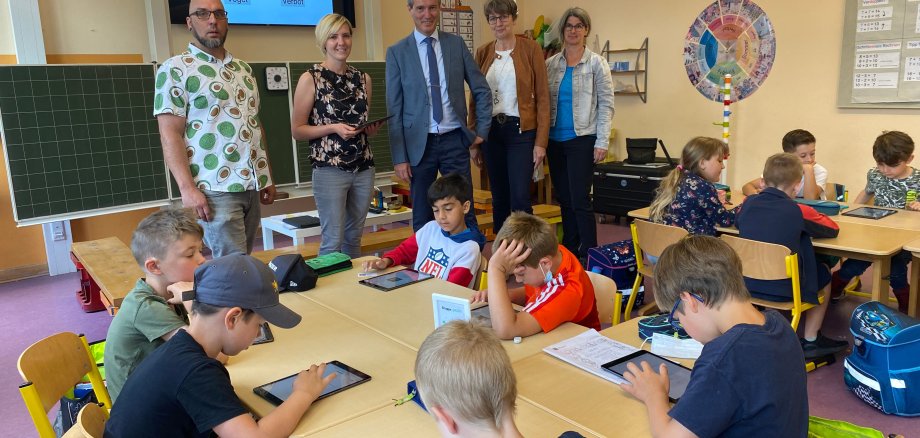Rainbow School uses wireless technology for interactive lessons
Digitisation is an important building block in the education of children and young people. Therefore, the district is constantly pushing it forward to enable digitally supported learning and teaching for pupils and teachers. At the Regenbogenschule in Frankenberg, wireless presentation technology is already part of everyday teaching.
Together with the Henkelschule in Vöhl and the primary school in Geismar, it is one of the first schools in Waldeck-Frankenberg where the measures of the Digital Pact have been almost completely completed. This means: Internet connections and rooms have been converted so that wireless presentation technology can now be used in all classrooms. This has a great added value for teaching: the imparting of knowledge can be supported by interactive learning programmes, teaching videos or films.
Arrived in the digital future
"The motivation among the children is huge," says Marco Scheithauer, head of the Frankenberg Regenbogen School, happily. "We have now arrived in the digital future. The digital possibilities promote learning processes and the joy of playing, and especially practice phases can be made even more entertaining this way." District Administrator Jürgen van der Horst was also convinced of this during his visit to Class 1b of the primary school. Equipped with a tablet, the ABC children practised different letters and sounds in a special learning programme.
"The children are highly motivated. The fact that we not only use interactive learning programmes, but can also easily project content onto a large screen in the classroom, offers a completely new form of learning," reports Jasmin Lehmann, the class teacher. The little ones are already very tech-savvy and are happy to be able to use technology in their everyday lessons. However, the good old blackboard has not been completely abolished: "The digital presentation technology is a great addition to a holistic teaching concept," says Lehmann.
10.4 million euros in investments over the next four years
Promoting this is also the goal of the district, which is responsible for equipping the schools in the district. The district of Waldeck-Frankenberg is investing 10.4 million euros over the next four years to improve digital networking, WLAN at schools and the purchase of equipment. All measures are to be implemented by summer 2025. "For the improvement of digital networking, the district is thus investing about four million euros, for interactive boards and displays about 3.5 million euros and for wireless internet almost three million euros," says District Administrator Jürgen van der Horst, giving an overview of the concrete use of the funds until 2025.
Equip schools as quickly as possible
"The goal of our digitalisation strategy in schools is to equip all buildings with the appropriate technology as quickly as possible," the district administrator continues. But since this cannot be done all at once, there is a priority list. When deciding which schools are to be equipped when, the existing digital equipment, the state of technical expansion, construction or renovation measures already underway or planned, the type of school and the location all play a role. "We implement measures that can be implemented quickly very quickly," the district administrator continues. This mainly involves the purchase of accessories for screens and presentation technology.
In order to provide even better information about the current state of digitalisation in schools, the district of Waldeck-Frankenberg has set up a large topic area on its website. From the fibre optic cable in the ground to the tablet in the classroom: Interested parties can find out online at www.landkreis-waldeck-frankenberg.de/digitalisierungderschulen what steps are being implemented to make schools fit for the digital future.
When will my school be digitised? Who provides which end devices? Where can I get the software I need? In addition to a lot of basic information about the digital pact and the state of expansion at the schools, the district has also compiled answers to these and other questions on the online portal. Since there is also an overlap in matters of digitisation with the tasks of the State Education Authority in Fritzlar, which is responsible for the district, the district worked together with the State Education Authority when creating the site - and also integrated a lot of helpful information from the Education Authority into the site.
